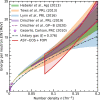Constraining neutron-star matter with microscopic and macroscopic collisions
- PMID: 35676430
- PMCID: PMC9177417
- DOI: 10.1038/s41586-022-04750-w
Constraining neutron-star matter with microscopic and macroscopic collisions
Abstract
Interpreting high-energy, astrophysical phenomena, such as supernova explosions or neutron-star collisions, requires a robust understanding of matter at supranuclear densities. However, our knowledge about dense matter explored in the cores of neutron stars remains limited. Fortunately, dense matter is not probed only in astrophysical observations, but also in terrestrial heavy-ion collision experiments. Here we use Bayesian inference to combine data from astrophysical multi-messenger observations of neutron stars1-9 and from heavy-ion collisions of gold nuclei at relativistic energies10,11 with microscopic nuclear theory calculations12-17 to improve our understanding of dense matter. We find that the inclusion of heavy-ion collision data indicates an increase in the pressure in dense matter relative to previous analyses, shifting neutron-star radii towards larger values, consistent with recent observations by the Neutron Star Interior Composition Explorer mission5-8,18. Our findings show that constraints from heavy-ion collision experiments show a remarkable consistency with multi-messenger observations and provide complementary information on nuclear matter at intermediate densities. This work combines nuclear theory, nuclear experiment and astrophysical observations, and shows how joint analyses can shed light on the properties of neutron-rich supranuclear matter over the density range probed in neutron stars.
© 2022. The Author(s).
Conflict of interest statement
The authors declare no competing interests.
Figures







Comment in
-
Diverse data tighten constraints for neutron stars.Nature. 2022 Jun;606(7913):258-259. doi: 10.1038/d41586-022-01532-2. Nature. 2022. PMID: 35676425 No abstract available.
References
-
- Abbott BP, et al. GW170817: observation of gravitational waves from a binary neutron star inspiral. Phys. Rev. Lett. 2017;119:161101. - PubMed
-
- Abbott B, et al. GW190425: observation of a compact binary coalescence with total mass ∼ 3.4M☉. Astrophys. J. Lett. 2020;892:L3.
-
- Abbott BP, et al. Gravitational waves and gamma-rays from a binary neutron star merger: GW170817 and GRB 170817A. Astrophys. J. 2017;848:L13.
-
- Coughlin M, et al. Toward rapid transient identification and characterization of kilonovae. Astrophys. J. 2017;849:12.
-
- Miller MC, et al. PSR J0030+0451 mass and radius from NICER data and implications for the properties of neutron star matter. Astrophys. J. Lett. 2019;887:L24.
Publication types
LinkOut - more resources
Full Text Sources

